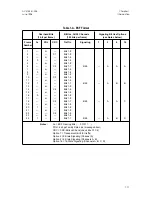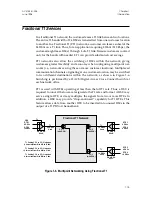
Pulse Density
To interpret and regenerate a T1 signal, repeaters and other T1 equipment must
be able to determine time slots based on the pulses in the received signal. Since
pulses occur only when ONES are transmitted, signals with too many consecu-
tive ZEROS cause timing problems.
The minimum frequency of ONES pulses (called pulse density) that is necessary
to ensure reliable timing varies with the equipment involved. However, a
standard pulse density requirement has been defined by AT&T:
N pulses in every 8(N+1) bits, where N = 1, 2, . . . 23
One of the corollaries of this formula is that no more than 15 ZEROS may be
transmitted consecutively. (If N = 1, there must be at least 1 pulse in every 16
bits.) This requirement was very important in the past, when repeaters would
tend to oscillate if they received more than 15 consecutive ZEROS, and an
oscillating repeater required manual resetting. However, most repeaters cur-
rently being deployed on T1 facilities can handle up to 80 consecutive ZEROS.
Pulse density requirements may be enforced by either the DTE or the DSU/CSU,
depending on the particular application. Pulse density may be guaranteed in
various ways:
•
A particular bit position (generally, bit 7 or 8 of each data byte) may
be reserved for the transmission of a pulse.
•
A pulse may be “stuffed” in the data stream (i.e., a ZERO may be
overwritten with a ONE) to ensure that pulse density is maintained.
•
Data may be bundled or encoded in a way that guarantees an accept-
able pulse frequency.
Another pulse density issue involves the transmission of a keep-alive signal to
the T1 line whenever signal is lost from the DTE. The keep-alive signal is a fixed
bit pattern (usually unframed ALL-ONES) which provides required pulses to
the network while notifying the far end that a failure has occurred.
Note:
Where dc power is available from the T1 span, a CSU
may be required to transmit a keep-alive signal to the network
in the event of a local power failure. Currently, however, the
implementation of dc-powered (“wet”) spans is decreasing.
Chapter 1
ACST-0351-005
Introduction
June 1996
1-6













































